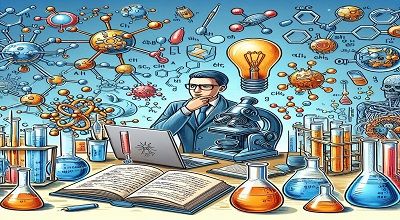Confused Words in Chemistry Manuscripts
Now here are the latest 8 Commonly Confused Words in Chemistry Manuscripts. Many chemistry terms sound similar but have different meanings. This can cause confusion and errors in writing chemistry manuscripts. Here are some of the most commonly confused words in chemistry and how to use them correctly:
- Chemical vs. Chemical Compound: A chemical is any pure substance, whether it is an element or a compound. A chemical compound is a substance composed of two or more elements chemically bonded together. For example, water (H2O) is a chemical compound, while hydrogen gas (H2) is a chemical.
- Molarity vs. Molality: Molarity (M) or concentration refers to the number of moles of solute per liter of solution. Molality (m) expresses the number of moles of solute per kilogram of solvent. For example, a 0.1M solution of sodium chloride means there are 0.1 moles of sodium chloride dissolved in one liter of solution. A 0.1m solution of sodium chloride indicates there are 0.1 moles of sodium chloride dissolved in one kilogram of solvent.
- Equilibrium Constant vs. Reaction Quotient: The equilibrium constant (Keq) describes the ratio of product concentrations to reactant concentrations at equilibrium. The reaction quotient (Q) represents the ratio of concentrations at any point during the reaction. For example, if Keq = 4 for a reaction, it means that at equilibrium, the products are four times more concentrated than the reactants. If Q = 2 for the same reaction, it means that at that moment, the products are twice as concentrated as the reactants.
More Read…
- Stereoisomer vs. Conformational Isomer: Stereoisomers are molecules that have the same molecular formula and connectivity, but differ in the spatial arrangement of their atoms. Conformational isomers are a type of stereoisomers that can interconvert by rotation around single bonds. For example, ethane (C2H6) has two conformational isomers: staggered and eclipsed. They have the same molecular formula and connectivity but differ in the relative orientation of the two methyl groups.
- Photoluminescence vs. Fluorescence: Photoluminescence is the emission of light by a material after absorbing photons. Fluorescence is a type of photoluminescence that occurs when the emitted light has a longer wavelength (lower energy) than the absorbed light. For example, a fluorescent material can absorb ultraviolet light and emit visible light.
- Yield vs. Conversion: Yield and conversion are both measures of the efficiency of a chemical reaction. Yield refers to the amount of product obtained from a reaction, expressed as a percentage of the theoretical maximum amount. Conversion refers to the amount of reactant consumed in a reaction, expressed as a percentage of the initial amount. For example, if a reaction has a 90% yield. It means that 90% of the theoretical maximum amount of product was obtained. If a reaction has an 80% conversion, it means that 80% of the initial amount of reactant was consumed.
Read More…
- Limit of Detection vs. Limit of Quantification: Limit of detection (LOD) and limit of quantification (LOQ) are both measures of the sensitivity of an analytical method. LOD is the lowest concentration of an analyte that can be detected by the method, but not necessarily quantified. LOQ is the lowest concentration of an analyte that can be quantified by the method with acceptable accuracy and precision. For example, if a method has a LOD of 1 ppm and a LOQ of 5 ppm. It means that the method can detect the presence of an analyte at 1 ppm, but can only measure its concentration reliably at 5 ppm or higher.
- Therapeutic Index vs. Safety Margin: Therapeutic index and safety margin are both measures of a drug’s safety. The therapeutic index compares the dose required for therapeutic effect to the dose that produces toxicity. A high therapeutic index indicates a wide margin of safety. The safety margin compares the dose that produces toxicity to the dose that produces adverse effects. A high safety margin indicates a low risk of adverse effects. For example, if a drug has a therapeutic index of 10 and a safety margin of 5, it means that the dose that causes toxicity is 10 times higher than the dose that causes therapeutic effect, and the dose that causes adverse effects is 5 times higher than the dose that causes toxicity.
